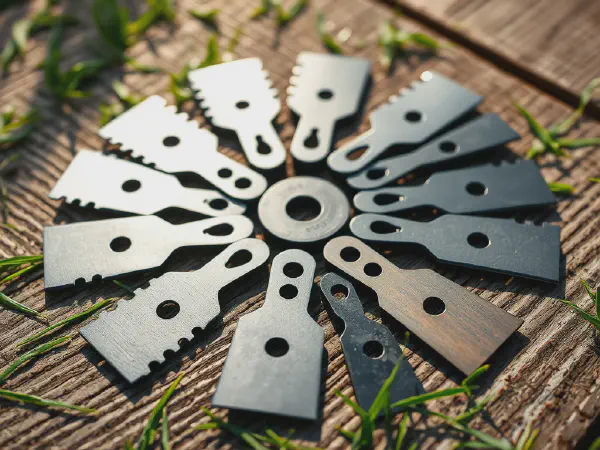Choosing the Best Mulching Blades for Your Lawn

Mulching Blades: Benefits and Maintenance
Mulching blades are an essential tool for any lawn care enthusiast. These specialized mower blades are designed to finely chop grass clippings and distribute them evenly back onto the lawn, acting as a natural fertilizer. In this article, we will explore the different types of mulching blades, their benefits, how to choose the right one, and proper maintenance and care.
Mulching blades work by creating a vacuum effect, lifting the grass and cutting it repeatedly until it is finely chopped. The finely chopped clippings then fall back onto the lawn, where they rapidly decompose, returning nutrients to the soil. This process is known as grasscycling and provides several advantages for your lawn.
One of the key benefits of using mulching blades is increased nutrient recycling. Instead of bagging or raking the clippings, which removes valuable nutrients from the lawn, mulching blades allow these nutrients to be returned to the soil. This natural fertilization promotes healthy grass growth, reduces the need for additional fertilizers, and improves overall soil health.
In addition to nutrient recycling, mulching blades also contribute to improved lawn health. The finely chopped grass clippings act as a protective layer, retaining moisture in the soil and reducing water evaporation. This helps to keep the grass roots hydrated and minimizes the risk of drought stress. Mulching also prevents weed growth by blocking sunlight and creating a barrier for weed seeds to germinate.
Another advantage of mulching blades is reduced lawn maintenance. Since the clippings are finely chopped and distributed evenly across the lawn, there is no need for bagging or raking. This saves time and effort, allowing you to mow the lawn quickly and efficiently. Mulching also eliminates the need for yard waste disposal, reducing environmental impact.
Types of Mulching Blades
There are three main types of mulching blades: Standard Mulching Blades, Gator Mulching Blades, and High-Lift Mulching Blades.
Standard Mulching Blades are the most common type and are suitable for general mulching purposes. They have a curved design that lifts the grass, creating a suction effect and minimizing the clippings' size.
Gator Mulching Blades have a unique design with multiple cutting surfaces and teeth. They provide excellent mulching performance, especially in thick and wet grass. The teeth on the blade aid in cutting the grass into smaller pieces, enhancing the mulching process.
Benefits of Mulching Blades
One of the primary benefits of mulching blades is increased nutrient recycling. By leaving the clippings on the lawn, the nutrients from the grass are returned to the soil, promoting healthy growth and reducing the need for additional fertilizers.
Mulching blades also improve lawn health by acting as a protective layer. The finely chopped grass clippings help retain moisture in the soil, reducing water evaporation and keeping the grass roots hydrated. This, in turn, minimizes the risk of drought stress and promotes a lush, green lawn.
Using mulching blades reduces lawn maintenance significantly. There is no need to bag or rake the clippings, saving time and effort. The finely chopped clippings also eliminate the need for yard waste disposal, reducing environmental impact.
Choosing the Right Mulching Blades
When choosing mulching blades, consider factors such as lawn size and type, mower compatibility, and blade material and design.
Lawn size and type play a crucial role in selecting the right mulching blades. For larger lawns, blades with a higher cutting capacity and more aggressive cutting action may be preferable. Different grass types may also require specific blade designs.
Ensure that the mulching blades you choose are compatible with your mower. Check the manufacturer's recommendations or consult a professional to ensure the blades will fit and function correctly with your mower model.
How to Install Mulching Blades
Installing mulching blades is a straightforward process if you follow these steps:
To install new mulching blades, start by preparing your mower for maintenance. Turn off the engine and disconnect the spark plug for safety.
Next, remove the old blades by securing them with a block of wood and using a socket wrench to loosen and remove the retaining bolt. Be careful when handling the blades as they may be sharp.
Maintenance and Care for Mulching Blades
Regular cleaning of mulching blades is essential to prevent clippings and debris from accumulating, which can affect performance. After each use, remove any grass clippings and debris from the blades using a stiff brush or garden hose.
Sharpening mulching blades should be done regularly to maintain their cutting efficiency. Use a sharpening tool or take them to a professional sharpening service. Dull blades will tear the grass instead of cutting it cleanly.
Over time, mulching blades may become worn out and lose their effectiveness. If the blades are damaged or no longer provide a clean cut, it is recommended to replace them with new ones. Regularly inspect the blades for signs of wear and replace them as needed.
